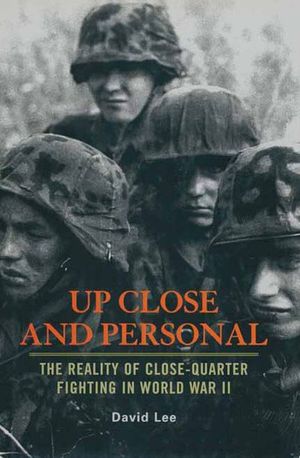Up Close and Personal
Published by Pen & Sword Books
An in-depth analysis of what it was really like to fight at the sharp end in every theater of the Second World War from the author of Beachhead Assault.
In 1947, US General S. L. A Marshall controversially wrote that out of every one hundred combat soldiers only fifteen to twenty-five actually fired their weapons at the enemy, because of the innate human reluctance to take another’s life. Others maintained the opposite view that soldiers enjoyed killing.
David Lee demonstrates that the situation was far more complex than either of these positions, arguing that the crucial factor for a unit’s success in battle was the type of training it received. To illustrate this Lee covers actions from each theater of the war, in depth and with comprehensive coverage of weapons and tactics. First there is the story of what happened when a battalion of British soldiers trained in the traditional manner came up against the Waffen SS, whose training was formidable and bore close resemblance to the Commandos. The success of No. 4 Commando at Dieppe is covered to show how this was put into effect. For the desert war there is a detailed look at how a rifle battalion held the snipe position against overwhelming odds, and how that same battalion was virtually wiped out when it later went to Italy. For the Far East, Lee explains how hatred of the Japanese Army gave impetus to British soldiers fighting at Kohima and American soldiers at Iwo Jima. And finally there is the story of one US infantry regiment on D-Day.
In 1947, US General S. L. A Marshall controversially wrote that out of every one hundred combat soldiers only fifteen to twenty-five actually fired their weapons at the enemy, because of the innate human reluctance to take another’s life. Others maintained the opposite view that soldiers enjoyed killing.
David Lee demonstrates that the situation was far more complex than either of these positions, arguing that the crucial factor for a unit’s success in battle was the type of training it received. To illustrate this Lee covers actions from each theater of the war, in depth and with comprehensive coverage of weapons and tactics. First there is the story of what happened when a battalion of British soldiers trained in the traditional manner came up against the Waffen SS, whose training was formidable and bore close resemblance to the Commandos. The success of No. 4 Commando at Dieppe is covered to show how this was put into effect. For the desert war there is a detailed look at how a rifle battalion held the snipe position against overwhelming odds, and how that same battalion was virtually wiped out when it later went to Italy. For the Far East, Lee explains how hatred of the Japanese Army gave impetus to British soldiers fighting at Kohima and American soldiers at Iwo Jima. And finally there is the story of one US infantry regiment on D-Day.
BUY NOW FROM
COMMUNITY REVIEWS

